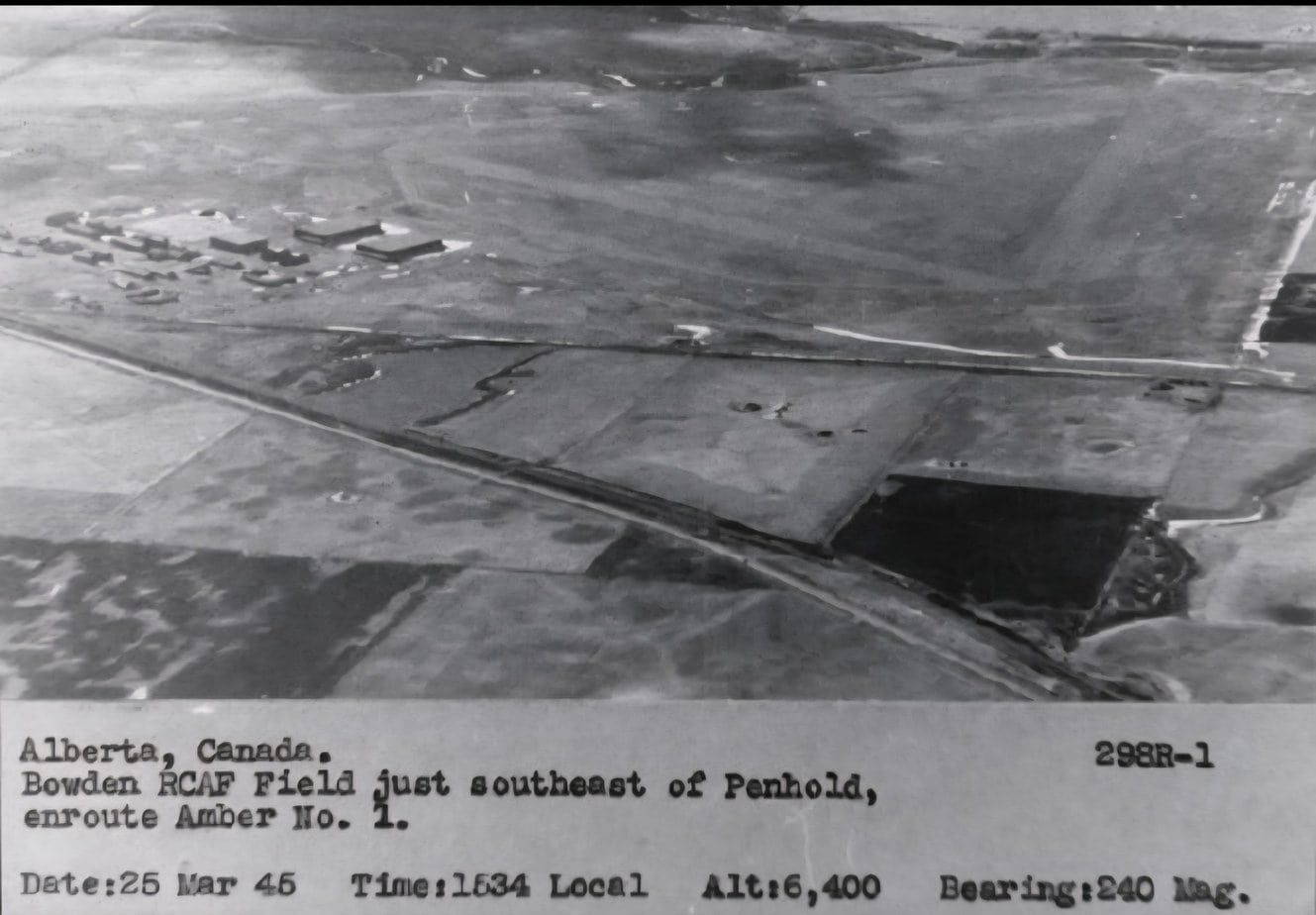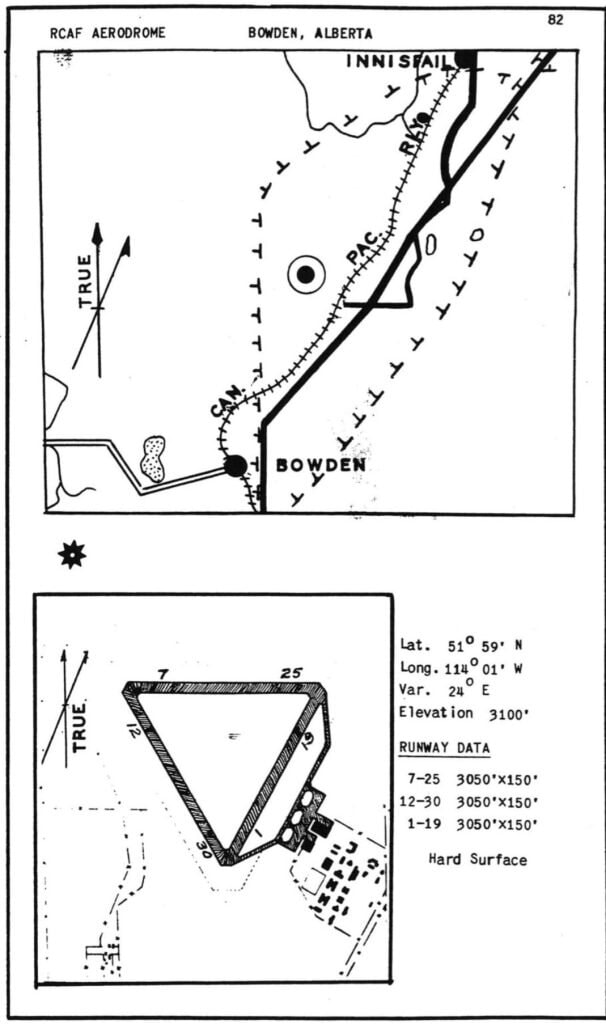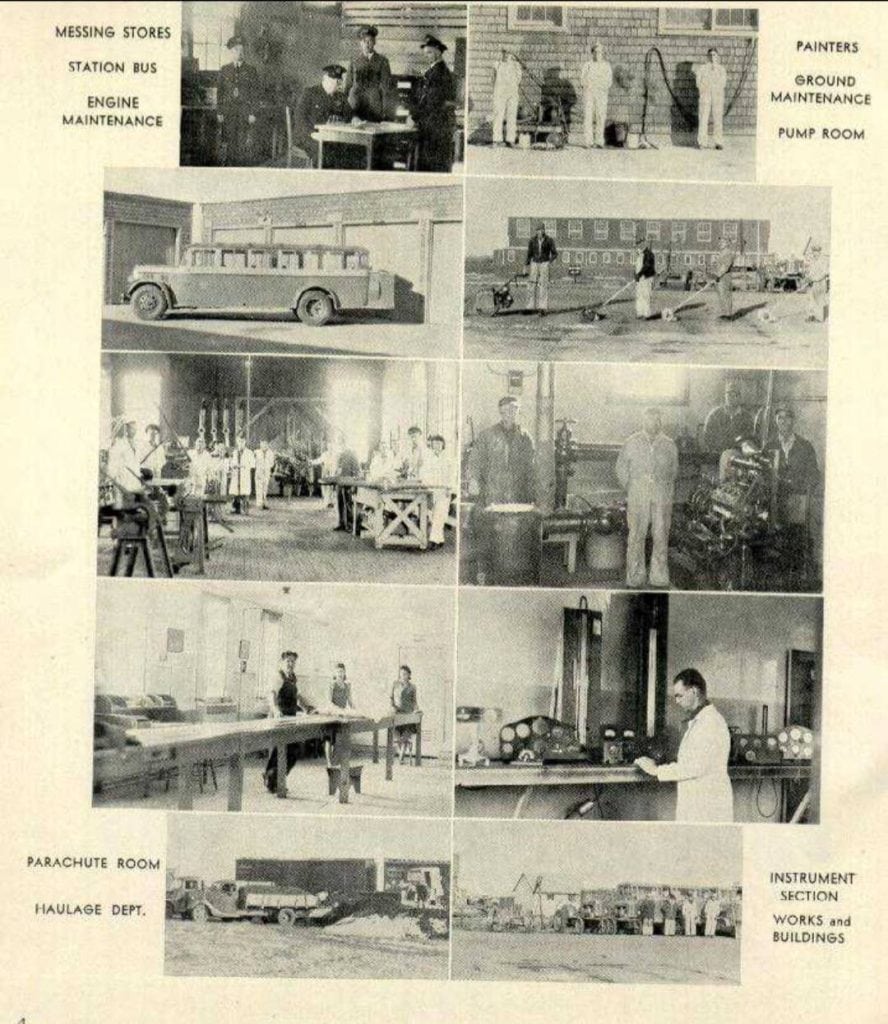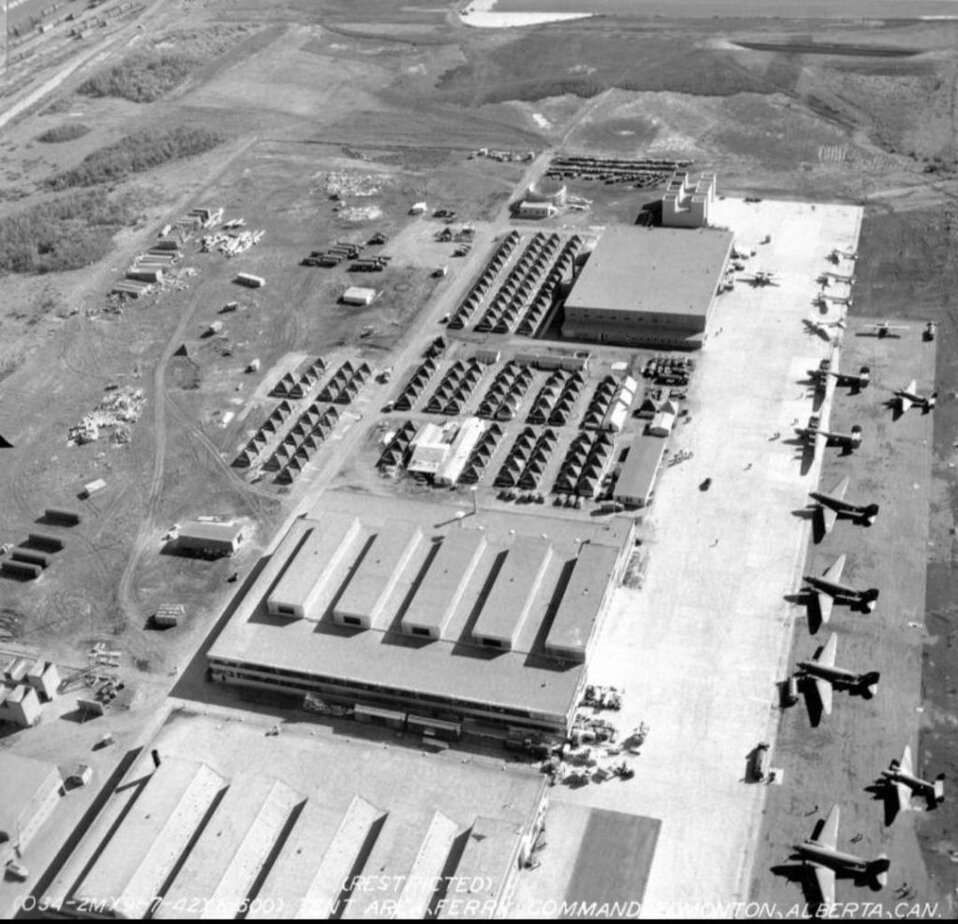FROM WINGS TO WALLS:
THE COMPLETE HISTORY OF THE BOWDEN INSTITUTION SITE
Republished with the gracious permission of the Bowden Historical Society.
(Republished from a post on facebook by the Bowden Historical Society – 14 June 2025)

Situated on the rolling prairies of Alberta, just north of the town of Bowden, the Bowden Institution site embodies a unique and layered chapter of Canadian history. This land has borne witness to sweeping national changes — from wartime mobilization to juvenile reform and finally to federal incarceration. Each era tells a story of transformation and adaptation, revealing evolving social values, government priorities, and community relationships. This essay offers an extensive account of the Bowden site, tracing its journey from a Royal Canadian Air Force training base, through its role as a provincial reform school, to the medium-security federal penitentiary it is today.
PART I: THE MILITARY BEGINNINGS — RCAF STATION BOWDEN (1941–1944)
The British Commonwealth Air Training Plan: Canada’s Skyward Contribution
In 1939, as the Second World War erupted, Canada launched one of the largest and most ambitious training programs of the era — the British Commonwealth Air Training Plan (BCATP). Canada’s vast open spaces, favorable weather, and distance from conflict zones made it an ideal location to train thousands of pilots and aircrew from across the Commonwealth, including Canada, Britain, Australia, and New Zealand.
The BCATP trained over 130,000 aircrew between 1939 and 1945, playing a crucial role in sustaining Allied air operations. The program involved dozens of training schools across the country, each specializing in different flight phases, from elementary flying to advanced operational training.

No. 32 Elementary Flying Training School at Bowden
In July 1941, the Bowden site was commissioned as No. 32 Elementary Flying Training School (EFTS) under the BCATP. Located roughly 4 kilometers north of Bowden town, the airbase was strategically designed with a classic triangular runway configuration—each runway approximately 3,050 feet long and surfaced with hard material to accommodate the training aircraft.
Facilities included:
- Four large aircraft hangars
- Barracks for students and staff
- Classrooms for ground school training
- A control tower
- Maintenance workshops
Initially operated by the Edmonton Flying Club under contract, the Royal Canadian Air Force assumed full operational control in July 1942.
Aircraft and Training Curriculum
Students learned to fly a range of primary training aircraft, designed for novice pilots to develop basic airmanship:
- de Havilland Tiger Moth: A light biplane renowned for its stability and maneuverability, widely used throughout BCATP schools.
- Fairchild PT-26 Cornell: A monoplane primary trainer introduced mid-war, with an enclosed cockpit that better simulated operational aircraft.
- Stearman PT-17: An American biplane used extensively in North America for primary pilot training.

Training involved:
- Basic flight maneuvers
- Navigation and instrument flying
- Emergency procedures
- Formation flying
The intense course typically lasted around 12 weeks, after which graduates moved on to more advanced training schools.
People and Experience
- The trainees were often young men, some barely 18 years old, who left small towns and cities across Canada and beyond to answer the call of duty. They endured rigorous schedules, sometimes flying twice daily in challenging prairie weather conditions. Discipline was strict, but camaraderie and a shared sense of purpose fostered lasting bonds.
- One veteran, now in his nineties, recalled decades later:
- “We were just kids, flying tiny planes over the endless fields, dreaming of the day we’d join the fight. Bowden was where we learned to trust the sky.”
- Though few detailed personal stories survive, records indicate that around 1,200 to 1,500 pilots trained at Bowden during its operational years.

Closure and Legacy
- By 1944, as the tide of war turned decisively in favor of the Allies, the demand for new pilots diminished. The BCATP began winding down, and No. 32 EFTS was decommissioned later that year. The airfield remained intact but fell into disuse.
- The Bowden airbase was a vital node in the largest air training program in history and contributed significantly to Canada’s wartime effort.
Additional Information:
- Strategically, Bowden’s location on the Alberta prairies provided vast open skies free from obstacles or dense population, which was essential for safe flight training and emergency landings. The relative isolation also minimized distractions for trainees, allowing a focused training environment.
- Beyond training, the base fostered morale through recreational facilities such as a gymnasium, a mess hall with social events, and regular movie nights. Trainees often formed informal clubs and sports teams, which were essential to building esprit de corps.
- Maintenance crews worked tirelessly to keep the fleet airworthy, often repairing battle damage and wear-and-tear under tight deadlines. Ground crews handled refueling, engine checks, and upkeep, all vital to the smooth operation of the school.
- There were occasional accidents, typical of flight training, though no major disasters at Bowden. The relatively low casualty rate contributed to the school’s reputation as a safe but challenging place to learn to fly.
- Graduates from Bowden went on to serve in diverse theaters of war — European fronts, the Battle of Britain, and North Africa — their foundational skills forged on Alberta’s flatlands.
PART II: THE REFORM SCHOOL ERA — BOWDEN PROVINCIAL CORRECTIONAL INSTITUTE (1951–1974)

Context and Creation
- In the postwar period, Alberta and the rest of Canada grappled with rising juvenile delinquency and evolving attitudes toward youth justice. There was a growing consensus that rehabilitation and education were more effective than mere punishment for young offenders.
- In 1951, the provincial government repurposed the dormant Bowden airbase into the Bowden Correctional Institute, colloquially known as the Bowden Reform School. It was one of Alberta’s main juvenile institutions, designed to house and rehabilitate boys and girls aged 14 to 19 who were sentenced or placed there by court order.
- Population and Demographics
- The institution typically housed between 80 and 120 youth at a time.
- Over its 23 years, approximately 3,500 to 4,500 juveniles passed through its doors.
- The population was predominantly male; girls accounted for roughly 10-15%.
- Youth were admitted for a range of offenses including theft, vandalism, truancy, assault, and substance abuse.
Governance and Staff
- The school was overseen by the Alberta Department of Social Services and later the Department of Juvenile Services. The Board of Directors comprised provincial officials, child welfare experts, and community leaders. Notable figures included:
- Harold E. Briggs, Superintendent (1955–1972), who championed vocational training expansion.
- Rev. William Nokes, Chaplain, known for his pastoral care and community outreach.
- Dorothy Thompson, Education Coordinator, who developed academic programs.
- Staff numbered approximately 60 to 80 full-time employees, including:
- Educators and vocational trainers
- Correctional officers
- Psychologists and social workers
- Medical staff
- Kitchen and maintenance personnel
Physical Facilities and Daily Life
- The facility utilized former military buildings retrofitted into dormitories, classrooms, workshops, and recreational spaces. The surrounding grounds included farmland and a greenhouse.
- A typical day involved:
- Morning assembly and chores
- Academic classes in math, English, history, and social studies
- Vocational training sessions in trades and farming
- Recreational time with sports and arts
- Counseling and spiritual services
- Evening reflection and preparation for next day
Vocational Programs
- Bowden was notable for its comprehensive vocational curriculum, including:
- ○ Carpentry and woodworking
- ○ Welding and metalworking
- ○ Auto mechanics
- ○ Agriculture: livestock care, crop cultivation
- ○ Culinary arts and food service
- ○ Sewing and textiles (primarily for female residents)
- ○ Youth often worked on-site farms and greenhouses, producing food for the institution and gaining practical skills.
Conditions and Controversies
- While Bowden was considered progressive relative to other reform schools, life was still regimented and challenging. Youth were confined and supervised at all times. Reports show:
- Escape attempts occurred but were infrequent and mostly unsuccessful.
- Occasional disciplinary incidents, including fires and confrontations.
- No major confirmed cases of abuse have surfaced in official records, though some former residents recall the strict discipline could be harsh.
Success Stories and Community Impact
- Many former residents went on to lead productive lives, crediting Bowden with teaching them marketable skills and discipline.
- One alumnus reflected:
- “Bowden gave me a second chance. I learned how to fix cars and stay out of trouble. The teachers cared, even when we didn’t show it.”
- The local community generally supported the institution, with many staff living in Bowden and volunteering in town activities. The school’s agricultural output also benefited nearby markets.
Closure and Legacy
- By the early 1970s, juvenile justice reforms favored community-based programs, and funding priorities shifted. Bowden Reform School closed in 1974. Its legacy lives on as an example of mid-20th-century rehabilitative philosophy.
Additional Information:
- The reform school’s philosophy aligned with the emerging Canadian youth justice model emphasizing rehabilitation over punishment, which influenced the design of the programs at Bowden. It pioneered a holistic approach combining education, vocational training, and counseling—a model that influenced other provincial institutions.
- Regular special events included “Graduation Days” where youth demonstrated skills learned, sometimes inviting families and community members, helping break down stigma.
- Staff underwent ongoing training on youth psychology and behavior management, contributing to evolving treatment approaches during the institution’s lifespan.
- Bowden maintained partnerships with local businesses to help place graduates in apprenticeships or jobs after release, strengthening community ties.
- The farm operations were not just vocational but also therapeutic, providing youth with responsibility and purpose.
- While some disciplinary measures were harsh by today’s standards, records show efforts to reduce isolation and corporal punishment over time, reflecting changing attitudes toward juvenile corrections nationally.
PART III: THE FEDERAL PENITENTIARY ERA — BOWDEN INSTITUTION (1974–PRESENT)

Transfer to Federal Government
- Following the closure of the reform school, the Alberta government transferred the site to the Correctional Service of Canada (CSC) in 1974. The facility was converted into a medium-security penitentiary for adult offenders.
Population and Facilities
- Bowden Institution houses approximately 650 inmates, including federal offenders serving sentences typically between 2 and 10 years.
- The facility includes cell blocks, vocational workshops, a health unit, recreational areas, and administrative offices.
- It employs over 300 staff, including correctional officers, parole officers, healthcare workers, educators, and Indigenous liaison officers.
Inmate Demographics and Offenses
- The inmate population is diverse, including Indigenous Canadians, non-Indigenous Canadians, and some foreign nationals. Common offenses include:
- Property crimes (theft, break and enter)
- Drug-related offenses
- Violent crimes (assault)
- White-collar crimes
Rehabilitation and Programs
- In keeping with Canadian correctional philosophy, Bowden focuses on rehabilitation through:
- Educational programs (literacy, GED preparation)
- Vocational training (construction trades, horticulture, maintenance)
- Substance abuse treatment
- Anger management and cognitive behavioral therapy
- Indigenous cultural programs, including Elder guidance and ceremonies
Working Conditions and Staff Life
- Staff at Bowden work under challenging conditions, balancing security with rehabilitation mandates. Correctional officers undergo rigorous training and maintain 24/7 security presence.
- The institution fosters a team environment, with ongoing professional development and community outreach programs.
Challenges and Incident Statistics
- Like many correctional facilities, Bowden grapples with:
- Occasional inmate conflicts and assaults (incident rates are comparable to other medium-security prisons)
- Overcrowding pressures during federal system surges
- Mental health and addiction issues among inmates
- The CSC releases annual incident reports but typically Bowden maintains a stable safety record.
Additional Information:
- Bowden’s security infrastructure includes multiple perimeter fences with electronic monitoring, controlled entry points, and surveillance cameras. These upgrades over the decades reflect evolving correctional security standards.
- Indigenous programs at Bowden have expanded to include sweat lodge ceremonies, talking circles, and regular visits from community Elders, fostering cultural reconnection and healing.
- Vocational programs now incorporate digital literacy and trades certification recognized by provincial authorities, improving reintegration prospects.
- Staff training emphasizes trauma-informed care, conflict resolution, and cultural competency, recognizing the complex needs of the inmate population.
- Bowden has participated in pilot restorative justice programs, inviting victim-offender mediation under controlled settings.
- Challenges faced include adapting to fluctuating inmate populations due to federal sentencing trends and responding to public health crises, such as COVID-19, which required modified operations.
- High-profile incidents are rare but handled with transparency to maintain public trust. Media coverage tends to focus on rehabilitation success stories and community partnerships.
BOWDEN IN CONTEXT: COMPARISONS AND HISTORICAL SIGNIFICANCE

Compared to other BCATP bases, Bowden was mid-sized but played a vital regional role.
- The reform school was among the more progressive juvenile institutions in Alberta, focusing on vocational rehabilitation rather than harsh confinement.
- Bowden Institution continues this legacy of balance between security and rehabilitation, adapting to modern correctional standards.
Additional Information:
- Bowden’s history parallels major Canadian social policy shifts: from wartime mobilization, through mid-century rehabilitation ideals, to contemporary correctional best practices.
- Its layered transformations provide insight into government responses to changing societal challenges over nearly a century.
- In comparison to other former BCATP sites, Bowden uniquely transitioned through three major institutional phases on the same land, symbolizing resilience and adaptation.
- The site reflects evolving national values: duty and sacrifice during war, compassion and second chances for youth, and balanced justice for adults.
A Site of Transformation and Service

- From its origins as a wartime pilot training base, to a provincial reform school for youth, and now a federal penitentiary, the Bowden site has continuously evolved to meet Canada’s changing social and security needs. Each chapter reflects broader themes of national service, rehabilitation, and correction.
- Its layered history offers a unique lens on Canadian values — resilience, second chances, and responsible governance — making Bowden a landmark in Alberta’s social landscape.
Sources
- Library and Archives Canada: British Commonwealth Air Training Plan records
- Alberta Department of Social Services Annual Reports (1951–1974)
- Correctional Service of Canada Annual Reports and Operational Data
- Bowden Historical Society Oral Histories
- Red Deer Advocate Archives (1940s–1970s)
- J. Babcock, Juvenile Justice in Canada, University of Alberta Press, 1991
- Alberta Council for Human Services Interview Transcripts (1974)
- Personal memoirs and interviews archived at Alberta Provincial Archives
